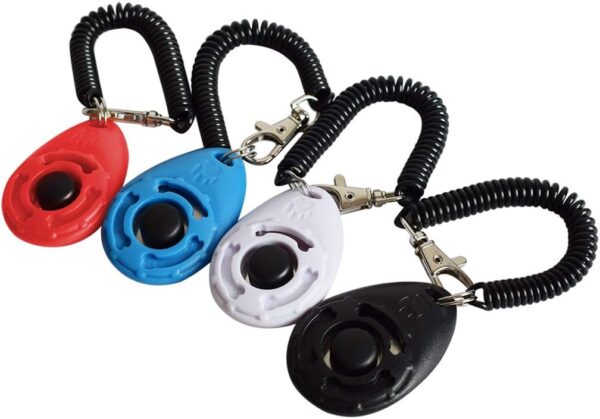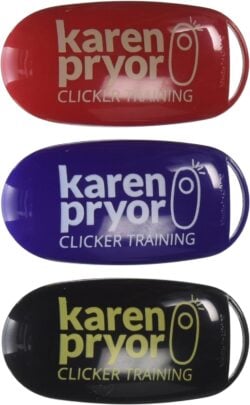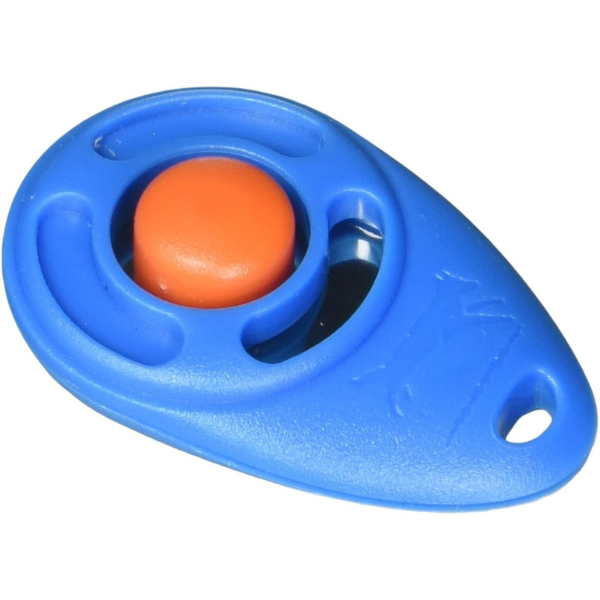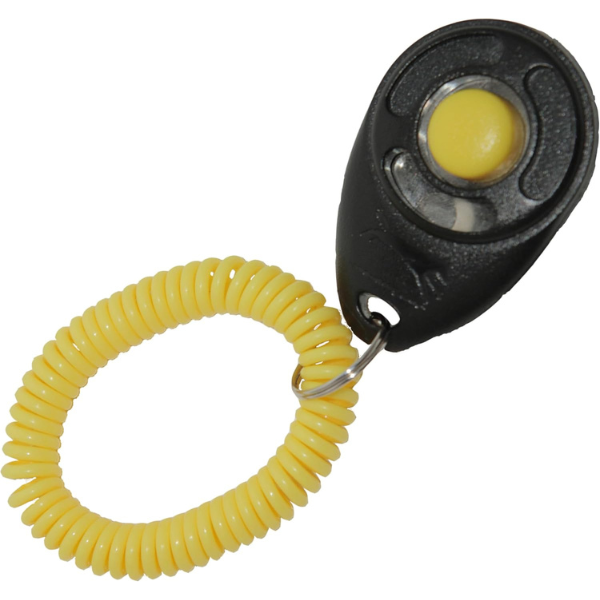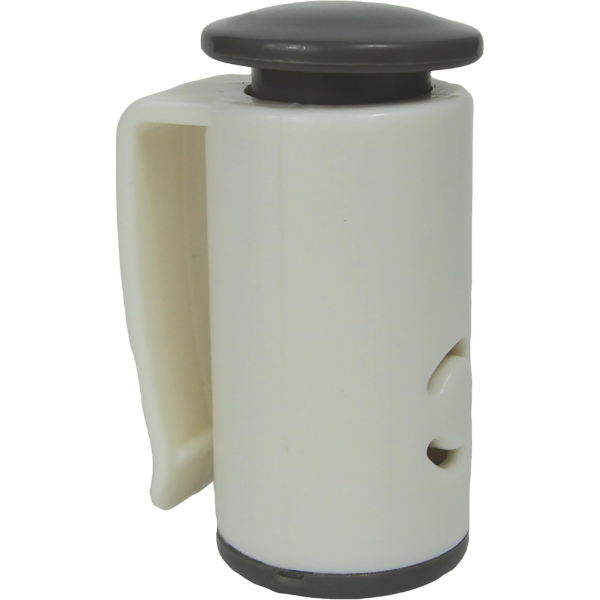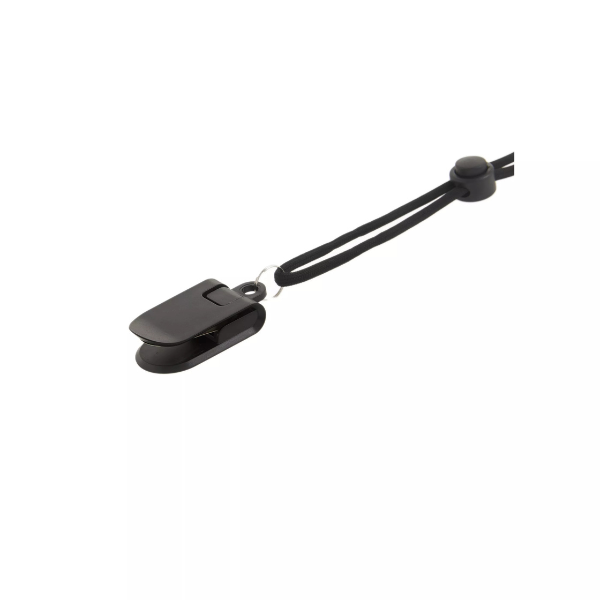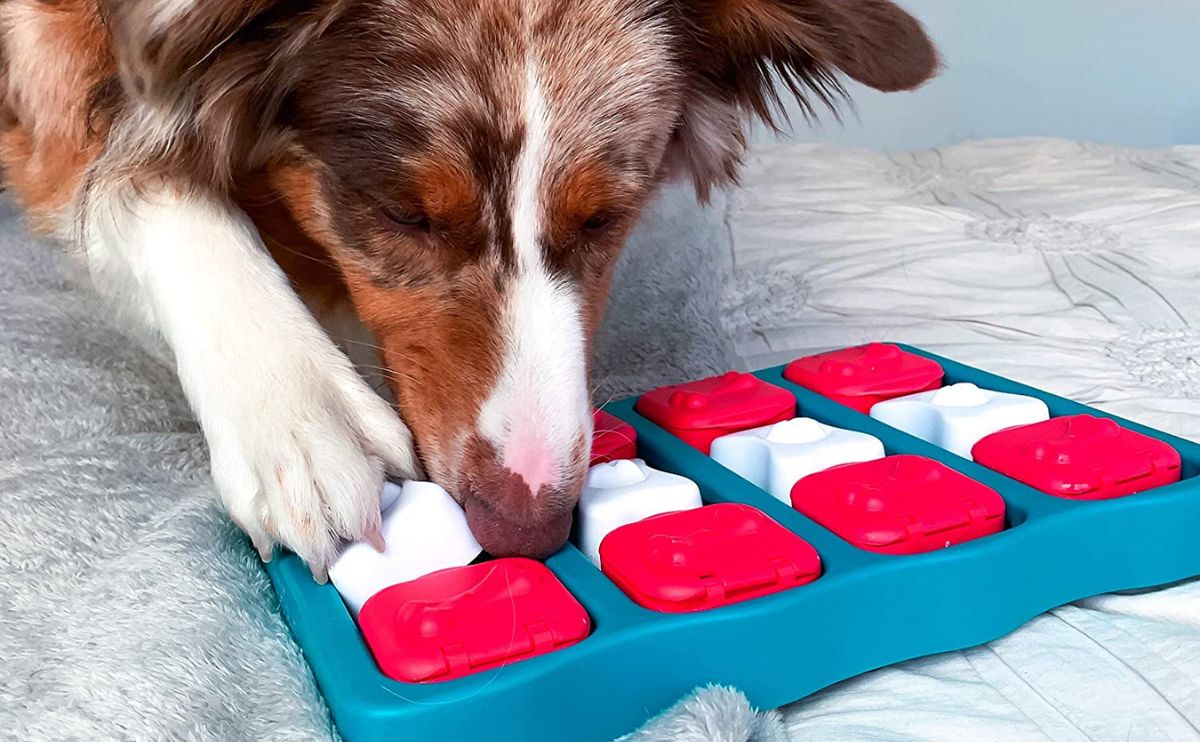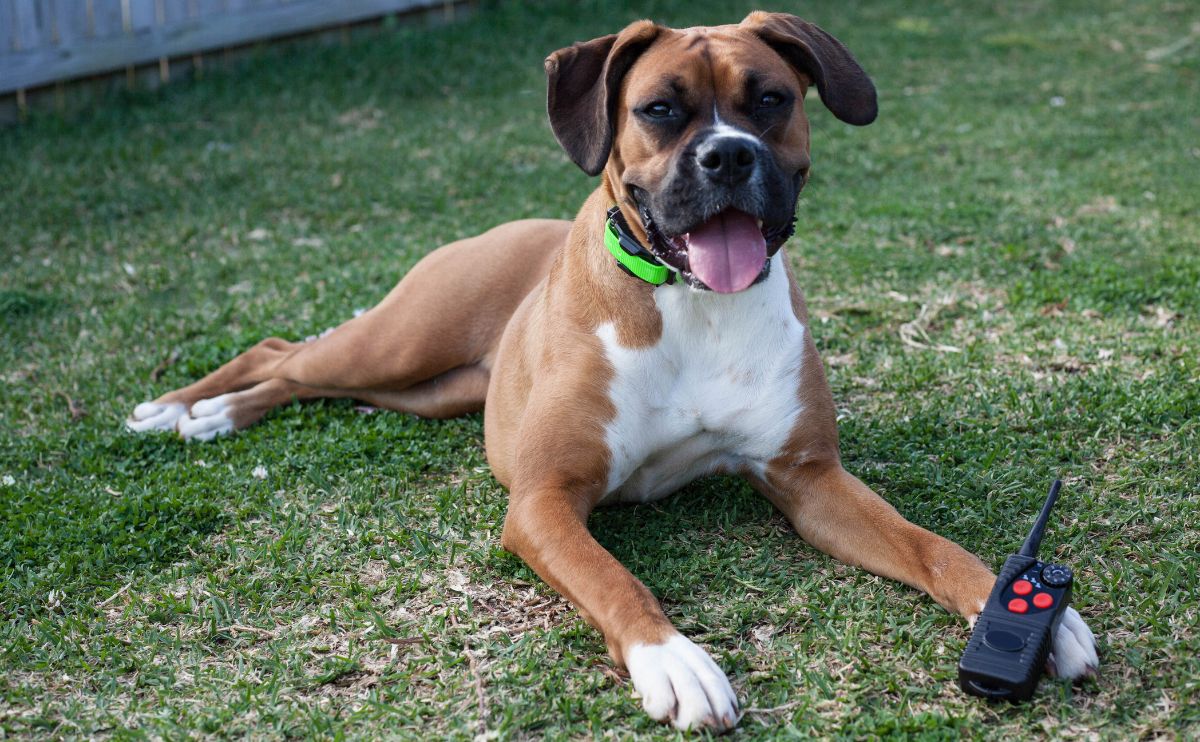4 Best Dog Training Clickers (We Tested 11 So You Don’t Have To!)
When you purchase through links on our site, we may earn a commission. Here’s how it works.
Training a new puppy or leveling up your dog training game? Many pros swear by clickers for better results. We put 11 popular clickers to the test — over 100 hours of clicking, testing, and real-world training. Which ones stood out? Here are the best dog training clickers we found.
Table of Contents
| Best Overall | For Sound-Sensitive Dogs | User-Friendly | Old-School |
|---|---|---|---|
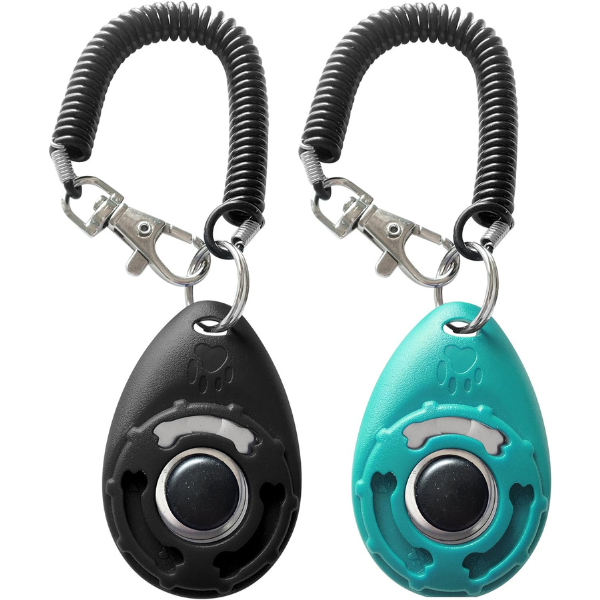 | 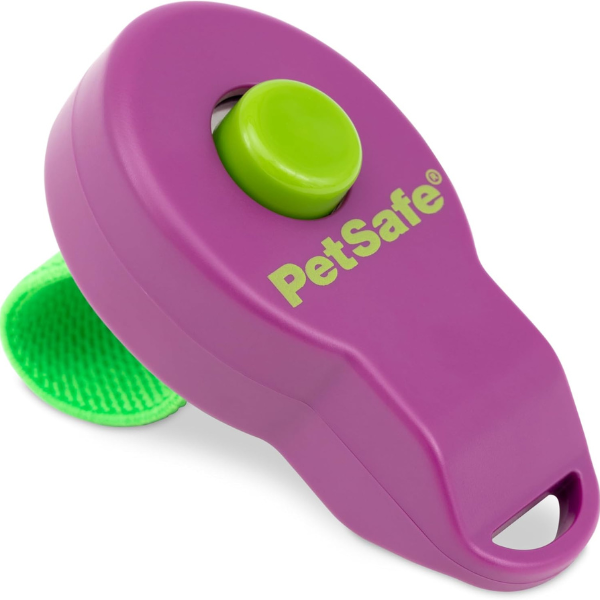 | 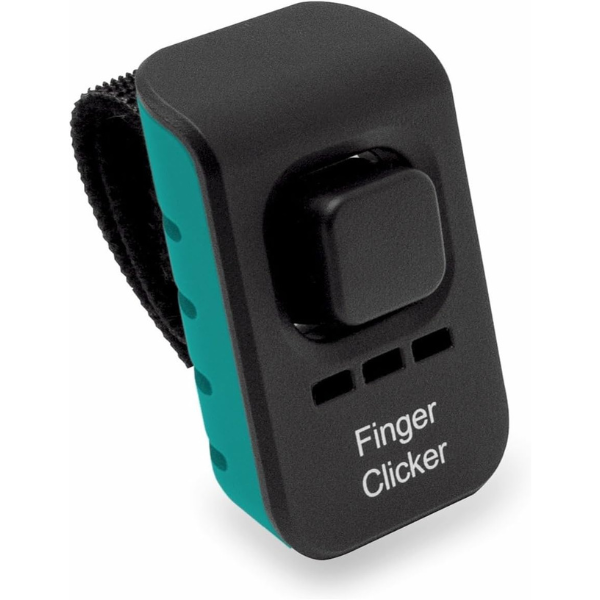 | 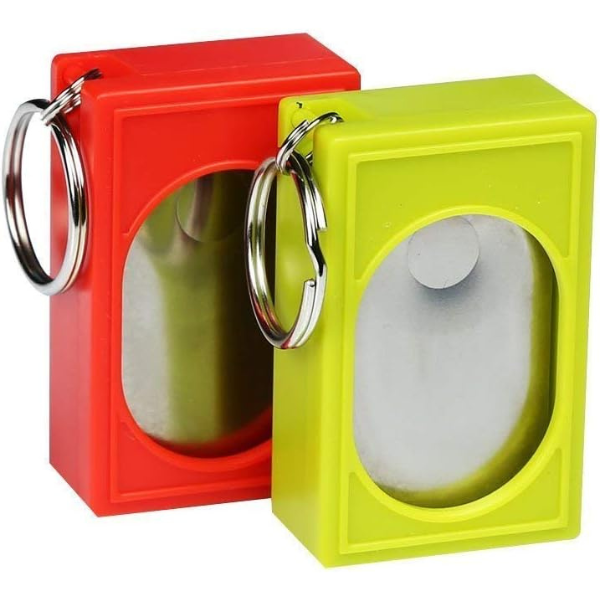 |
| HoAoOo | PetSafe Clik-R | Educator | CRMADA Box Clicker |
| View on Amazon | View on Amazon | View on Amazon | View on Amazon |
| Read Review | Read Review | Read Review | Read Review |
4 Best Dog Clickers
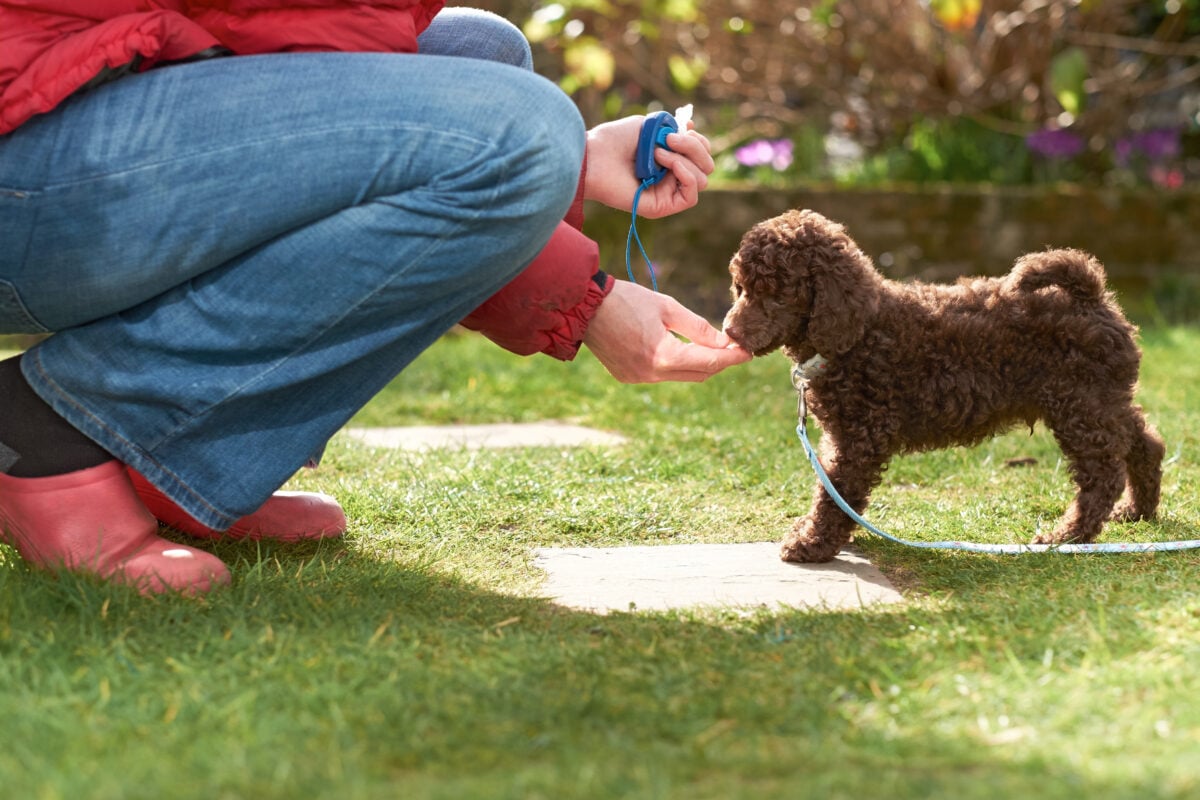
These four dog training clickers stood out for their durability, ease of use, and training results. Whether you’re a first-time puppy parent or a seasoned trainer, these picks are worth a look.
Best Overall: HoAoOo Pet Training Clicker Review
After testing several dog training clickers, the HoAoOo clicker stood out as the best. I loved how convenient it was to take on walks — the wrist strap made it easy to keep on hand without fumbling.
It’s also sturdier than most of the others I tried, and the click is nice and loud (without being obnoxious), which really helped grab my dog’s attention, whether we were indoors or outside.
It fits nicely in the palm of my hand, and the oversized button made it super easy to use, even during quick training sessions. Getting two high-quality clickers at this price felt like a steal.
I can see why so many trainers and pet parents rave about it, and I completely agree.
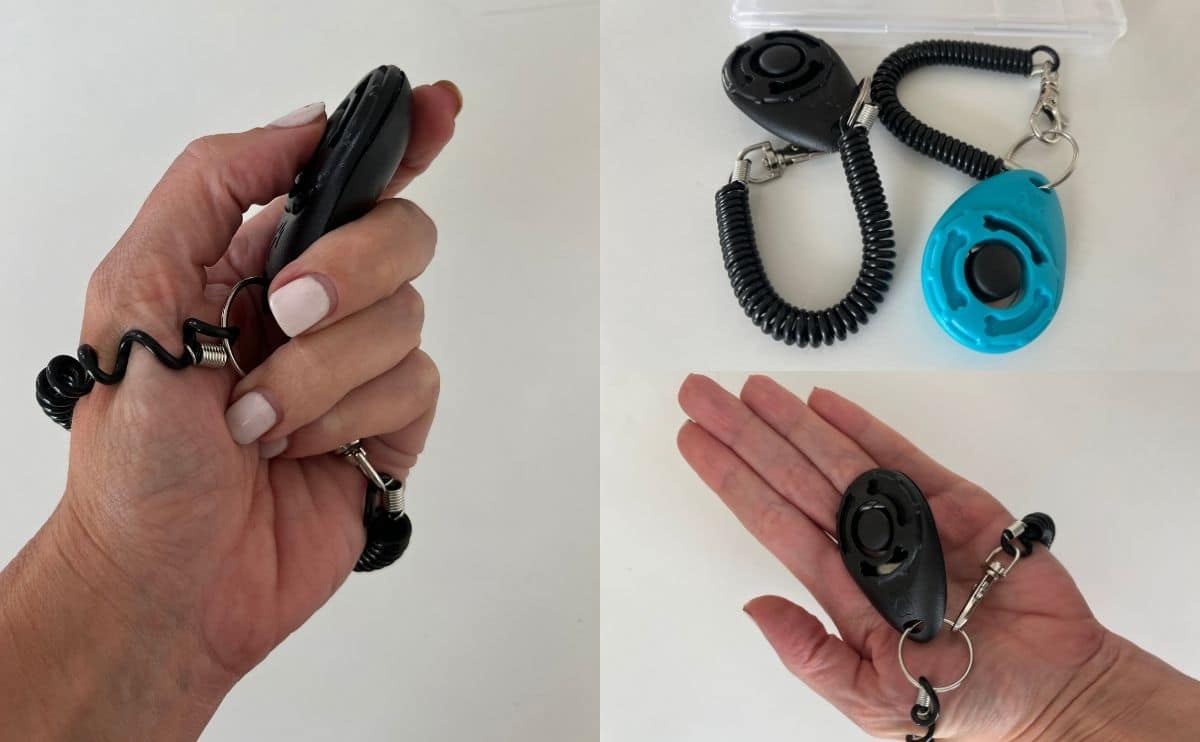
Price
Best For Sound-Sensitive Dogs: PetSafe Clik-R Dog Training Clicker Review
Roxy is a Yorkshire Terrier who is incredibly noise-sensitive. Sudden noises startle her delicate Yorkie ears. It was no surprise that most of the clickers I tested made her flinch, even when she knew a treat was coming.
The PetSafe clicker was the exception. She responded positively to the gentler click that was given off. Admittedly, it did take a few clicks before she was used to it, but the same can be said when introducing any dog to a clicker for the first time.
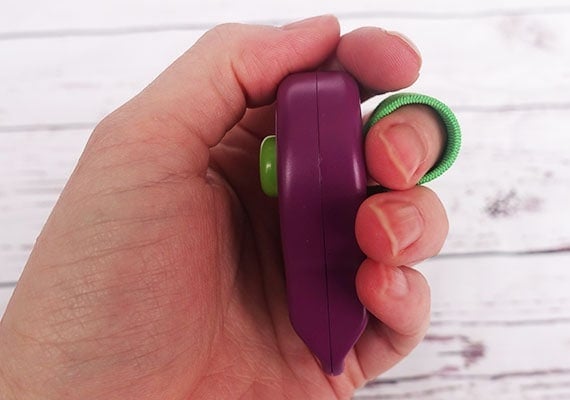
When we measured the PetSafe clicker with our noise meter, we discovered that it was 4x softer than the next quietest clicker.
Despite the gentler sound, our dogs easily identified the click during training. The tone may be less sharp, but it’s distinct. However, if you are distance training in an open field or noisy area, you might want something a little louder.
Price
Most User-Friendly: Educator Dog Training Finger Clicker Review
What makes this clicker so great is that it’s always within easy reach. Located on the back is an elastic strap that stretches over your fingers, holding it in place. I found it easier to handle than the PetSafe Clik-R.
If you’ve never tried a clicker with a finger loop, I thoroughly recommend making the upgrade. In my opinion, there is no going back.
I was able to hold Harper’s leah and treats and click this clicker all at once. It’s like having a third hand!
I was a little concerned about the thickness at first. It’s the thickest clicker I tested. However, even the thumb of my small, lady hands was easily able to reach the button without straining. I am pleased to report that the Educator performed just as well in my husband’s big, meaty paws, too.
The click is loud, crisp, and distinct. Harper flinched the first few times she heard it, but quickly got used to it.
Price
Best Old-School: CRMADA Box Training Clickers Review
If you want the loudest possible clicker, then this is it. If your dog has sensitive hearing or is scared of sudden sounds, then skip this. Compared to other clickers, it booms.
Interestingly, this is the old style of clicker. When I was first introduced to clicker training years ago, this was basically the only design available. It was interesting to observe that while newer clicker designs are more comfortable and easier to hold, you can’t beat the original in terms of loudness.
Instead of a button, you push your finger inside the box, bending a small piece of metal. As the metal pops back up, it makes a roaring click sound. It may sound tinny, but it sure is loud.
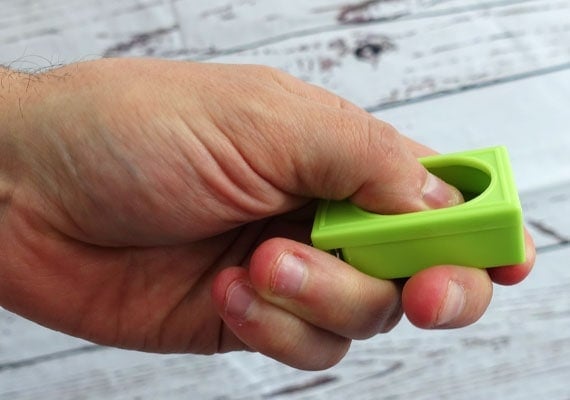
Over time, I noticed that the square shape became uncomfortable to hold. The hard plastic corners dug into the flesh of my palm. However, this was only really a problem during longer training sessions.
If your dog is hard of hearing or a great distance away, then the loud click is exactly what you want. However, due to its boxy design, I can’t recommend it as an everyday clicker.
Price
7 Dog Clickers That Didn’t Make The Cut
While the following dog training clickers didn’t make our top 4, many have their own strengths. All of them are functional and got the job done during testing, but they came up short in areas like durability, comfort, or consistency. Still, depending on your preferences or training style, one of these might be the right fit for you.
1. Ruconla Dog Training Clicker With Wrist Strap Review
Ruconla’s 4-Pack Dog Training Clicker with Wrist Strap would be our go-to pick for anyone looking to buy cheap clickers in bulk. Don’t be fooled by the price; these clickers are great. They are nearly identical to the StarMark Pro-Training Clicker Deluxe but without the flaws.
The elastic strap can clip to a belt loop or to the clicker to make a wrist strap. The click is loud and sharp. Available in a 4-pack, they offer incredible value for your money. My only complaint is that the button presses with minimal pressure, which can lead to accidental activation.
2. Karen Pryor i-Click Review
Karen Pryor is arguably the mother of clicker training. She helped bring clicker training mainstream back in the 90s. Unsurprisingly, she has her own line of dog clickers. While she still sells the traditional box clicker, the i-Click dog training clicker is by far the favorite.
As you would expect, these clickers get a lot of things right. They are easy to use, have a loud, crisp sound, and the large, raised button makes it more difficult to accidentally press.
However, the drawback to the button was that if you don’t press the center, and instead press the edge, it sticks and doesn’t make a clicking sound. Another downside is that there are no attachments included.
The lanyard loop found on the end of each clicker could also connect to a key chain or wrist band, but you’ll have to buy these separately. With all that said, Karen Pryor has created a strong contender.
3. StarMark Pro-Training Clicker Review
Next, the StarMark Pro-Training Clicker was the big letdown — the button sticks. Not every time, but often enough that it prevented consistently marking the training with a click. And when it comes to training, consistency is key!
This same flaw was found on all three clickers. It’s a shame because otherwise, there is a lot to love. The clicker feels good to hold, and the button is within easy reach.
4. StarMark Pro-Training Clicker Deluxe Review
The StarMark Pro-Training Clicker Deluxe is essentially the same clicker, only more expensive. What makes it deluxe is a change in color (black and yellow) and the inclusion of a coiled wrist band, a feature that comes standard on many of the other clickers we tested. Besides these minor differences, it has the same flaws as the base model — the button on the clicker gets stuck.
5. StarMark Triple Crown Pro-Training Quicker Clicker Review
The Triple Crown Pro-Training Quicker Clicker by StarMark was the only clicker that was borderline unusable. The unique cylinder shape of this clicker is designed to slide over a belt, waistband, or even the edge of a training pouch.
The problem is that this clip doesn’t grip. It sits loose, slips, slides, and falls off every few clicks. The only way I could hold it in place was by clipping it to the inside pocket of my jeans, but this position won’t be easily accessible for certain tricks, like shaking a paw.
It’s a shame. If the clip were better designed, I could easily recommend this clicker as an easy-to-hold alternative to the clickers with a finger strap.
6. Downtown Pet Supply Clicker Review
Out of all the clickers I tested, the Downtown Pet Supply Clicker was my least favorite by far. The design looks eerily similar to the Karen Pryor i-Click. That’s where the similarity ends, however, because this clicker performed worse in almost every way.
The narrow shape and gloss finish made the clicker difficult to grip. In fact, it was downright slippery. At least the bulky wrist cord stopped the clicker from falling to the ground while I was training, although the cord on one of the clickers broke in the first session.
Another had the clicker button fail so that it no longer clicked. The only redeeming feature is that these clickers come in a pack of 4 at a bargain price.
7. PetSmart Top Paw Pet Training Clicker
The Top Paw Pet Training Clicker is only available at PetSmart. This was the only clicker not to pass the crush test. It broke into pieces when I “accidentally” stepped on it. Otherwise, it’s just an average clicker. Given its price, we see no reason to recommend it over our cheaper top picks.
What Is A Dog Training Clicker, And Do You Need One?
A clicker is a small, hand-held device with a button. As the name suggests, when you press the button, it makes a distinct, loud “click” sound.

How a clicker works is quite simple. Inside the clicker is a small metal strip. When you press the button, it bends this strip. When you release the button, this metal strip pops up, making a click sound.
Yep. That’s it. A clicker is a simple, cheap device. But in dog training, it has a very specific use.
Let’s say you are training your dog to shake. Once your dog places his paw in your hand, you would say “good,” “yes,” or whatever phrase you want. Then, you give your dog a treat as a reward for completing the task.
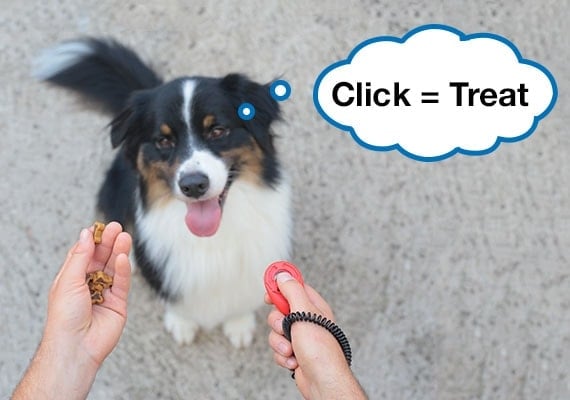
By saying this phrase, you let your pup know the exact behavior that results in the treat. Your pup will associate this sound with his reward. In dog training, this sound is referred to as the marker.
That’s where a clicker comes in. Instead of saying “good,” you simply press a button. This click sound becomes the marker.
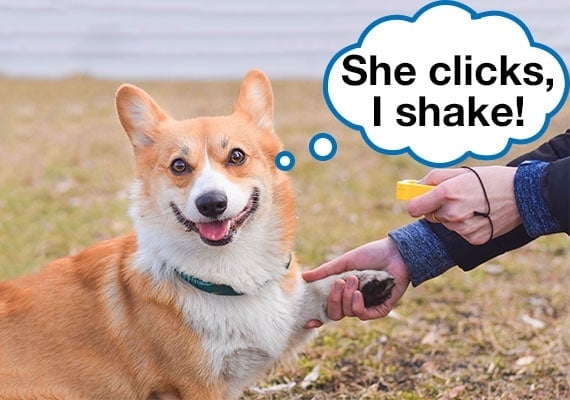
Don’t worry! You won’t have to use a clicker forever. Once your dog learns the new trick or behavior, you won’t need it anymore. A clicker is used in training only.

Benefits Of Using A Dog Clicker
Training your dog with a clicker is referred to as clicker training, and it offers a couple of advantages over using a voice marker.
- 1. Quicker and more precise – Many find it quicker to press a button at the exact moment your dog performs a task than saying a word.
- 2. Constant tone – The sound the clicker makes is the same every time. The sound of your voice can change, such as when you have a cold.
Now, you may be wondering:
Is A Clicker Necessary To Train Your Dog?
The effectiveness of using a clicker in dog training is still being debated. Some research indicates that using a clicker speeds up the rate at which dogs learn certain new behaviors.
However, most studies show that using a voice command is equally effective as using a clicker.
Even if the worst-case scenario is true, a clicker is still an effective training aid.
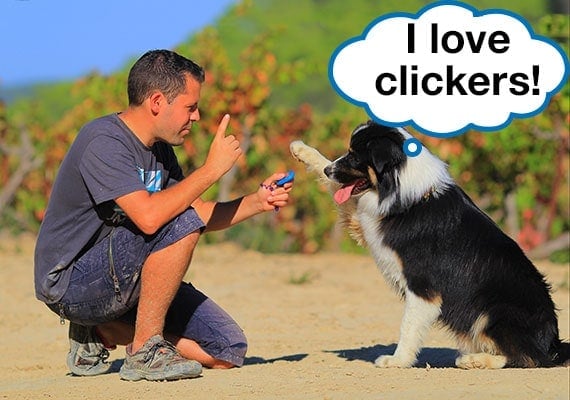
Interestingly, the majority of professional dog trainers we interviewed preferred using a clicker. They listed precision as the number one reason. Besides, when training dozens of dogs each day, your voice can get raspy when constantly yelling voice commands.

When I was a beginner with no previous dog training experience, I had a preference for using the clicker. Make no mistake, you can certainly train your dog without a clicker.
It is by no means an essential product. But based on my experience, if I had the choice to train with a clicker or skip it completely, I would use a clicker every time.
Still on the fence? Fortunately, clickers are very affordable. Even if this is another product that gets lost in the depths of your junk drawer, it will only cost you a couple of dollars.
Not training your dog or don’t plan to in the future? Then, you don’t need a clicker. Spend your money on dog products you do need, such as dog bowls and dog toys!
For long-distance dog training, you should use a dog whistle instead. The sound is louder and travels further. Check out our review of the best dog whistles for more info.
Our Testing Process
At Canine Journal, we take reviewing darn seriously. We would never recommend a product that we wouldn’t happily use with our own precious pooches. That’s why we thoroughly tested every clicker featured in this guide.
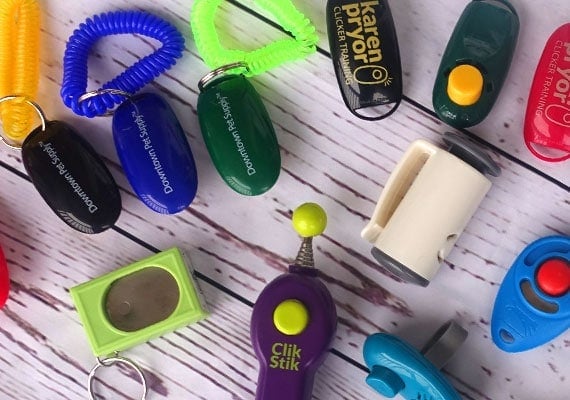
By the end of the process, we spent a combined 100+ hours researching, testing, and reviewing the most popular (and even some unpopular) dog training clickers on the market.
Since clickers are used to train dogs, it makes sense to test each clicker while training a dog, right? Let me introduce you to our training buddy:
Harper

Breed: German Shepherd x Border Collie mix
Harper has learned new tricks! She can now “wait,” “go ahead,” and be recalled when off the leash. Who knew a clicker, treats, and training were everything needed to turn this disobedient pup into a well-behaved pooch?
We also tested the clickers on a variety of other dogs, including a particularly timid Yorkie, a deaf French Bulldog, and a playful Labrador, to see how they would respond to the sound of each clicker.
Speaking of sound, I used a sound meter to rank each clicker by how loud it was. The noisier the clicker, the higher the reading.
Finally, I tested the following:
- Durability – Each clicker was stepped on with a rubber-soled shoe on a hardwood floor.
- Ease of use – How easy was it to activate each clicker during training?
Each of these factors contributed to which clickers we recommend. Our top picks excel in both these areas.
Our Testing Observations: 3 Top Tips
While testing the qualities listed above, we made some observations that are worth mentioning.
1. Most Clickers Have About The Same Loudness
Okay, I’ll admit that this surprised me a bit.
When we tested the sound, almost every clicker measured within 2 decibels of each other. To put this simply, most clickers are as loud as each other.
However, our human testers didn’t think so. When we asked them to rank how loud each clicker was, we received very different feedback.
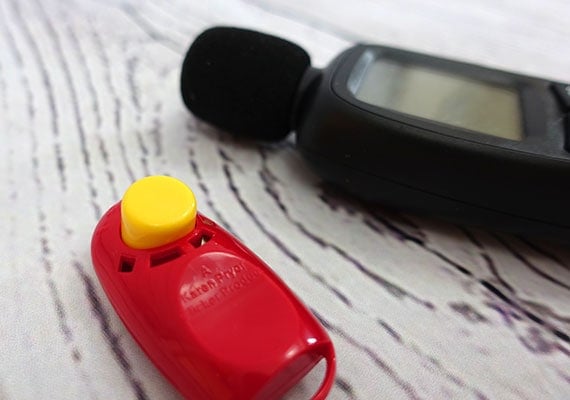
Why are the results so different? We suspect it comes down to the actual tone that each clicker makes rather than its loudness.
Clickers that made a loud, tinny sound were typically ranked as louder than those that made a crisper sound – even when they measured the same on our sound meter. I guess the takeaway is that you can’t trust your ears to determine the loudness of a clicker.
The softer-sounding clickers are suitable for puppies and dogs that are startled by loud noises. The loudest clickers are better suited for training in an open field when your dog is a good distance away.
2. You’ll Probably Need To Buy More Than One Clicker
Like most small pieces of plastic, clickers are easy to lose. Unless you are particularly organized, these small devices will get lost in your junk drawer or roll under the front seat of your car.
Even if you don’t lose it, there is always the possibility of it breaking. I accidentally crushed a clicker when I stepped on it while looking for where I dropped it.
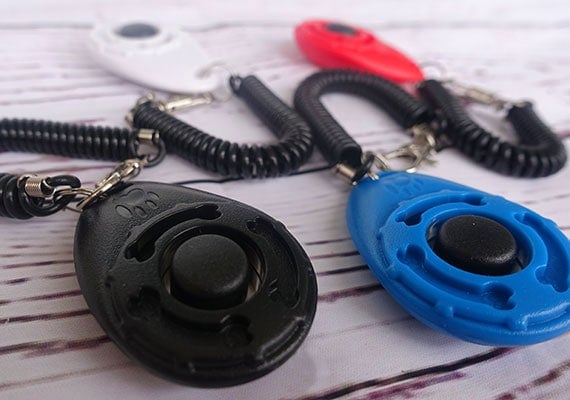
Trust me when I say this:
It’s very frustrating to go to train your dog only to realize you don’t have a clicker on hand.
Once you find your favorite clicker, buy a spare – just in case. This way, you won’t have to madly dash to the shops before your puppy training session.
Fortunately, many clickers come in packs of three or more. Whether you lose or break them, you’ll have another ready to use at a moment’s notice.
3. How You Hold The Clicker Matters
When training your dog, it often feels like you need an extra hand. While holding your dog’s leash in one hand and treats in the other, juggling a clicker can be difficult.
Because of this, many clickers come with a method of attaching the clicker to your body.
Some wrap around your wrist…
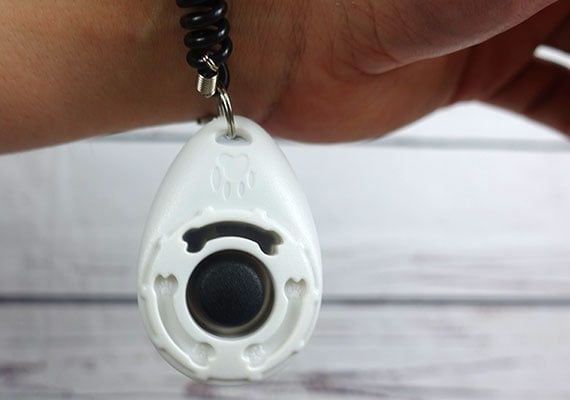
Others clip over your waistband, belt, or pocket…
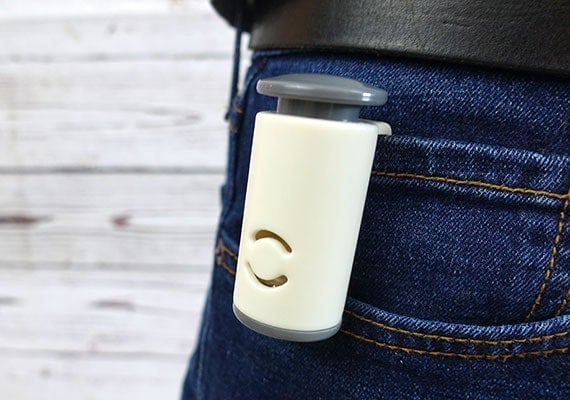
And others strap to your finger.
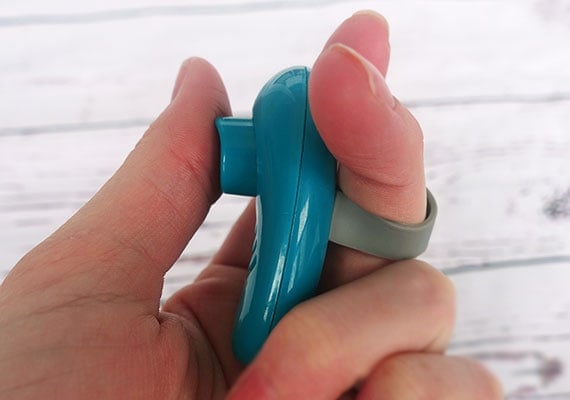
Some clickers came without these attachments, but they featured loops or rings that can attach to a lanyard or keychain.
During testing, I found the finger strap variety of clicker to work the best. While other attachments kept the clicker nearby, you still had to reach for them.
The strap kept the clicker in the palm of your hand without having to grip it with your fingers – it was always within easy reach of my thumb.
How To Train Your Pup Using The Best Dog Training Clicker
Phew, if you made it this far, congratulations! You now know which clicker is best for training your pooch. Now it’s time to learn how to clicker train. Head over to our ultimate guide on clicker training for step-by-step instructions and plenty of tips to help you make it effective.
